Ecological Systems |
Towra Point is an example of a complete wetland system, part of which you an see on out Towra Transact |
 |
Mangroves
Towra Point has two species of mangrove, the grey mangrove (Avicennia marina) and the river mangrove (Aegiceras corniculatum). The grey mangrove has numerous upright roots - called pneumatophores - (below) that poke out of the mud. It is these roots that allow the plant to breathe in the unoxygenated (anaerobic) muds. |
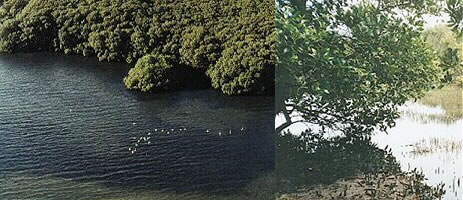 |
| Both species excrete salt out of their leaves and have the ability to change salt water into fresh. Mangroves produce significant amounts of leaf litter called “detritus”, which breaks down and provides food for aquatic plants and invertebrate animals. These are then eaten by fish and birds. Mangroves forests are often viewed as smelly, muddy, horrible places that have no use, however, the shoreline and surrounding water benefits greatly from the mangroves. Mangroves and Coastal Wetlands help reduce water pollution, provide shelter, refuge and food for many forms of wildlife, prevent bank erosion and act as visual screens and nurseries for fish species. |
| Wildlife found in the mangroves include common shore crabs which are abundant in the mangroves and live in complex networks of burrows deep in the substrate. Birds such as herons, egrets, ibises and spoonbills feed in the rich mud. The area of Towra Point covered by mangroves has been increasing in recent decades at the expense of saltmarsh. Looking at the diagrams below, you can see the changes. |
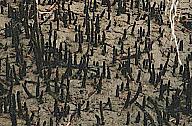 |
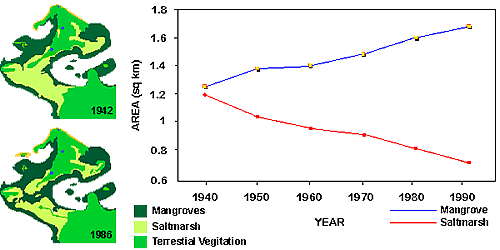 |
Saltmarsh
There are over 10 species of saltmarsh plants in the Reserve. They exist in areas that are subjected to both tidal (salt) and freshwater inundation. Of these, Glasswort is the most common. Areas of the brackish water reed Juncus krausii occupy the terrestrial margins of the saltmarsh (below left). Saltmarsh appear as open plains coloured green and red, dotted with the occasional mangrove (below right). |
|
| The Tidal inundation and rainfall help to form pools of standing water (above) which are also a feature of the marsh. The photo below shows an area of saltmarsh at a high tide of about 1.9m. The saltmarsh areas occupy about 100 hectares of Towra Point. Some areas of the saltmarsh are flooded regularly whilst other areas such as those occupied by Juncus are only occasionally flooded. The saltmarsh habitat at Towra is the last remaining in the Sydney region. Saltmarsh areas are favoured as a feeding site for Eastern Golden Plover, Eastern Curlew and Sharp-tailed Sandpiper. |
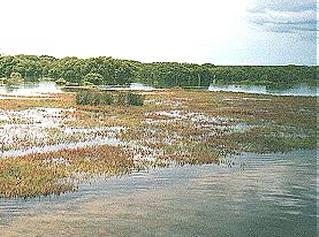 |
Rainforest
Small groves of littoral rainforest in the Reserve support the magenta brush cherry (Syzygium paniculatum), a species listed as 'vulnerable' in NSW. Another species found in this area is the Lilli Pilli (Acmena smithii) which supplies food to a number of birds such as rosellas and lorikeets. In the rainforest areas the canopy is sometimes closed, with an understorey of ferns, but seedlings are struggling to survive the impacts of lantana invasion. |
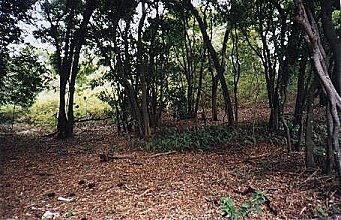 |
| Indeed if the lantana is not removed then pockets rainforest such as around Weedy Pond may not regenerate. The photo above shows an area of rainforest recently liberated from lantana by volunteers. |
Conservation
Click here to find out more about work to preserve the rainforest. |
|
Sandflat/mudflat
The areas of sand flat at the western end of Towra Beach are of particular importance for a number of species of waterfowl and migratory birds. They have large numbers of molluscs, polychaetes and small crustaceans. The mudflats at Quibray Bay (below) are also popular feeding areas for birds. |
 |
Some birds swim or wade in the shallows along the shoreline, spearing or catching their prey of fish, molluscs and other invertebrate animals. For more information on bird species look at our wildlife section.
Freshwater wetlands
The Reserve has a number of freshwater wetlands and ponds. These include Weedy Pond, and to a lesser extent, Towra Lagoon. Weedy Pond (below) is a small attractive pond which is fringed by casuarinas. It often remains dry for long periods but fills after heavy rain. Weedy Pond is also surrounded by a pocket of littoral rainforest. |
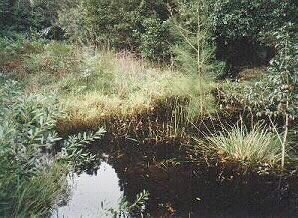 |
Towra Lagoon is the largest fresh water wetland in the Reserve and once supported three species of dabbling duck and the endangered green and golden bell frog. However, due to saltwater incursions from Botany Bay, these birds are rarely seen in the lagoon. The eastern-long necked tortoise was also an inhabitant of this lagoon but is intolerant of any salt and has also disappeared (along with the frog).
SeagrassesThe waters around Towra Point support meadows of seagrasses. The main species around Towra Point are eelgrass (Zostera), strap weed (Posidonia) and paddle weed (Halophila). |
|
Seagrasses grow below the low tide level in the sheltered shallow waters of estuaries. They are flowering plants and generally prefer soft sediments like sand or mud. Like any plant, seagrasses need light to grow and are often restricted to the upper two metres of water where there is sufficient light. The leaves are either straplike or paired oval leaves that grow from rhizomes (underground stems).
Seagrasses are important habitat for small aquatic animals, provide feeding and nursery grounds for fish and give shelter to juvenile and small adult fish and invertebrates such as prawns and crabs. Seagrasses also play a role in nutrient cycling in Botany Bay by providing nutrients in the form of detritus.
Casuarina forest
Another plant community found at Towra is the Swamp Oak forest which is characterised by tall Casuarina glauca trees as well as a species of Melaleuca ericifolia. Casuarinas have fruits which attract seed-eating parrots. This community is the first above the tidal influence and at Towra occurs just beyond the Juncus reeds of the saltmarsh (See transect picture above). Beyond this is the Bangalay forest, pockets of which are scattered throughout the Reserve.
Dune Sclerophyll Woodlands
These forests, which are characterised by species such as Teatree and Coast Banksia (Banksia integrifolia), occur on the Reserve’s many shorelines, including Towra Beach. The flowers of the Banksia provide a source of food for many species of honeyeaters. Unfortunately, the woodlands also suffer from infestations of weeds such as bitou bush and lantana which can often inhibit regrowth of these forests. |
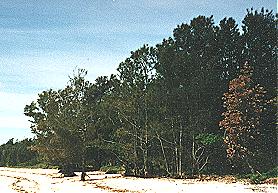 |
| top of page |



